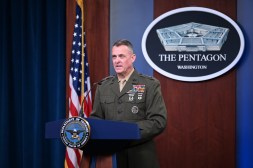The vast majority of JAIC’s money is going toward warfighting

The Department of Defense’s Joint Artificial Intelligence Center has spent more money in fiscal 2020 on its Joint Warfighting Mission Initiative than its five other focus areas combined, its acting director said Wednesday.
This marks an evolution for the JAIC as money for battlefield AI is outpacing projects that had an earlier head start, like the center’s continued humanitarian assistance work, JAIC acting Director Nand Mulchandani said Wednesday, without revealing specific budget numbers.
The Warfighting Mission Initiative got its first major contract award in April, with an $800 million deal going to Booz Allen Hamilton to help the JAIC coordinate with other private sector companies on bringing AI to the battlefield. Other mission initiatives include warfighter health, business process transformation, threat reduction and protection, joint logistics, and joint information warfare which includes cyber.
The JAIC has stressed that at every step of development, its ethics principles are considered and inform how the department works to implement AI into kill chains.
“I think about them all the time,” Mulchandani said about the ethics principles at a press conference.
One of the JAIC’s major focuses in its warfighting is developing AI that enables Joint All Domain Command and Control (JADC2), the next-generation network-of-networks the military is developing to link operations across sea, air, land, space and cyber. The AI in JADC2 will be used to link “every sensor to every shooter,” so the saying goes, by having a common data architecture and means to rapidly process that data to get information to the right part of the chain of command.
“That is going to be a big focus,” Mulchandani said of the program.
Another high-priority focus area is in what the JAIC calls “cognitive assistance.” This type of AI technology is designed to filter information and assist service members in the decisionmaking processes. Mulchandani described cognitive assistance as AI that is designed to assist those assessing potential targets of attack. In particular, the JAIC is working with natural language processing (NLP) that can sift through layers of text data to assess the important information and synthesize less valuable text.
Much of the JAIC’s work is happening in partnership with industry, Mulchandani said. Despite protests and worry inside some Silicon Valley companies, he said engagement remains strong both with large companies, like Google and Microsoft, and with small startups.
“We have deep engagement with industry,” he said, adding that the JAIC’s industry engagement specialist is based right in the heart of Silicon Valley.
Mulchandani pointed to offensive information warfare and cyber weapons as an area in which industry hasn’t yet progressed much. While building automated cybersecurity and event analysis tools has been a “well-trodden path” for industry for years, Mulchandani noted that when it comes to offensive cyber tools, “industry has just barely started.”
“There is a huge goldmine of work there,” he said.
Mulchandani said he could not go into details, but noted that JAIC is working with U.S. Cyber Command on some projects around offensive cybersecurity work.






